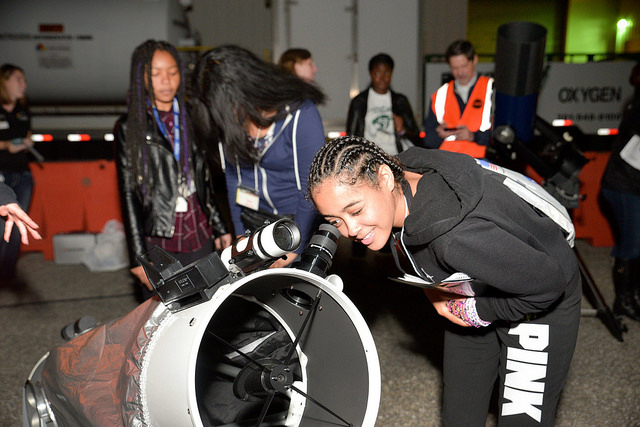
First-ever ‚ÄúSTEM Girls Night In‚Äù sleepover on Friday, Nov. 4, 2016, at NASA’s Goddard Space Flight Center. Credit: NASA/Goddard/Debbie Mccallum
When I signed the contract for my PhD project, a thought crossed my mind— should I let my maths teacher know? The one who advised me to pursue a hairdressing career, because girls were, “not made for higher education”? I was 14 at the time, and after that, my passion for anything numbers died a sudden death. I did go on to study art history, because they don’t do hair dressing at university, and never wasted a thought to the matter again.
Roughly 10 years later, the number of female STEM researchers in many countries is alarming. Even in leading industrial nations, such as the USA and Japan, female researchers don’t even make up 20% of the total. But what effective measures are taken by governments and companies to face the problem? The usual campaigns aim at A-level students, colleges and universities offer funds to STEM girls. But still, women in the field are a minority. What can be done to achieve parity? The answer is probably not a globally applicable solution; there will be a common start.
There is little motivation offered by society for girls to go into STEM fields from birth. After early criticisms and lack of support, girls typically move their interests elsewhere. When girls are disadvantaged in society, they tend to shy away from fighting for their goals. But what we need are empowered girls learning in an environment that lets them choose. Multiple studies have shown that girls outsmart boys in their age group. The lack of female rocket scientists isn’t due to the fact that women don’t have the brains. It’s because girls are raised with the notion that maths or chemistry just isn’t for girls. During my school days, there was a popular t-shirt reading, “I’m just decoration in the maths class”. In my year, there were just as many boys failing maths as there were girls, but none of the lads were wearing the t-shirt. But I remember a large number of girls proudly admitting they were just there to be seen.
As long as this continues, efforts to bring A-level students to choose STEM in university will likely fail. And if they don’t study STEM, the extra funds will not reach those that would need them. We have to start a lot earlier, in Kindergarten and primary school. And my own contribution will be to let my maths teacher know that he probably kept a capable student from choosing a viable path. It’s about choice and opportunity, not brains.
Check out Girl Museum’s exhibition for an in-depth exploration of¬†girls in STEM.
-Kristina Kraemer
Junior Editor
Girl News International
